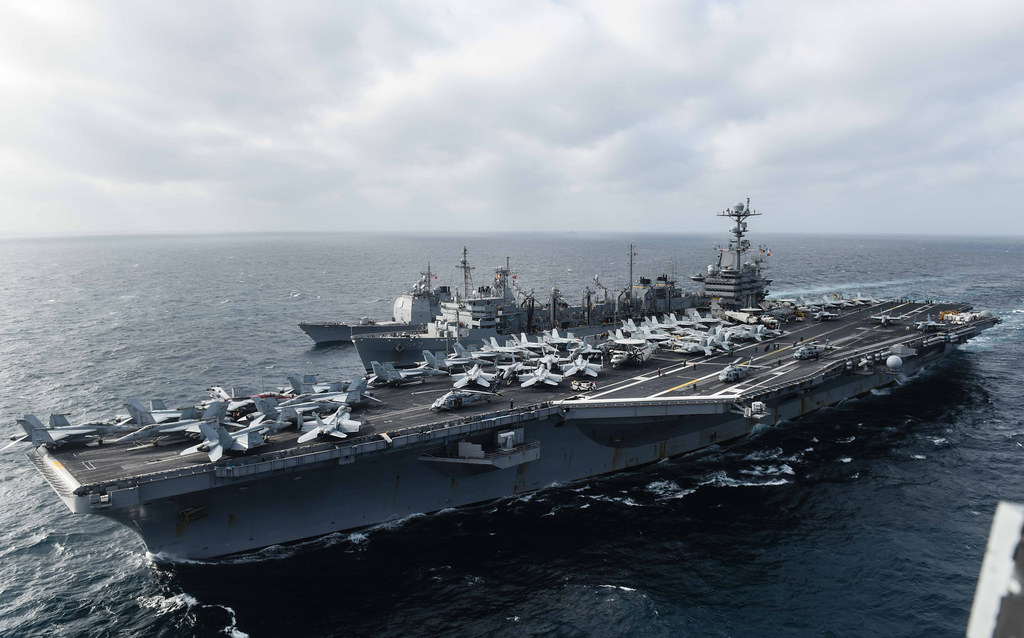From John C. Stennis Strike Group Public Affairs
In this file photo, USS John C. Stennis (CVN 74) participates in a replenishment at sea in March with USNS Rainier (T-AOE 7) and USS Mobile Bay (CG 53), which is receiving an advanced biofuel mixture. (U.S. Navy/MC2 Andrew P. Holmes) >>
PACIFIC OCEAN - Named to honor President Theodore Roosevelt's Great White Fleet, the Navy's Great Green Fleet is ushering in a new era of energy innovation.
A centerpiece of this yearlong initiative is John C. Stennis Strike Group (JCSSG), which departed on a regularly scheduled Western Pacific deployment in January and is scheduled to join the Rim of the Pacific (RIMPAC) exercise later this month.
Using alternative fuel sources, energy conservation measures (ECMs) and operational procedures, the strike group is transforming its energy use to become a more flexible fighting force.
"As a whole, these energy saving measures allow us to be on station longer and to do our job better," said Cmdr. Walter C. Mainor, commanding officer of USS William P. Lawrence (DDG 110). "The Navy has been at the forefront of energy innovation [for generations]. From coal to steam to oil, this is just another measure that the Navy is taking on and leaning forward for energy innovation."
Guided-missile cruiser USS Mobile Bay (CG 53), and guided-missile destroyers USS Chung-Hoon (DDG 93), USS Stockdale (DDG 106) and William P. Lawrence are all operating in the Indo-Asia-Pacific using alternative fuel.
Stockdale became the first naval ship to use the fuel blend for regular operations when it departed for deployment from San Diego, Jan. 20. Mobile Bay and the other destroyers received the biofuel during replenishments at sea from Military Sealift Command (MSC) ships.
The alternative fuel is made from 10 percent beef tallow provided from farmers in the Midwest and 90 percent marine diesel, and is cost competitive with traditional fuels. It is used as a drop-in alternative, meaning no modifications to engines or operational procedures are required.
The U.S. Navy's carrier fleet, including USS John C. Stennis (CVN 74) has operated using only an alternative fuel source, nuclear energy, since 2009. Nuclear power eliminates large-volume storage requirements for fuel, increasing capacity for other consumables and improving sustainability.
By diversifying energy sources, the Navy increases the operational flexibility of its ships and strengthens their ability to provide presence.
There's more to the Great Green Fleet than alternative fuel. JCSSG uses various ECMs including energy-efficient systems, and operational procedures to operate farther, stay on station longer and deliver more firepower.
Chung-Hoon's crew implemented a temperature control initiative in May, adjusting the settings of thermostats, ensuring that they are in proper working parameters, and finding and replacing faulty parts in the chill water cooling system.
"Chung-Hoon's temperature control initiative is comprised of many small goals, and when they're met, we're hoping to reach our ultimate goal of being a more energy efficient warship," said Cmdr. Vic Sheldon, Chung-Hoon's executive officer.
Sailors replaced legacy lighting fixtures aboard all JCSSG ships with solid state lighting (SSL) lamps that use light-emitting diodes (LEDs). The new bulbs are rated for 100,000 hours of service life, compared to the 100 hours of use of an incandescent bulb.
The cruisers and destroyers of the strike group all have stern flaps installed. These modify the flow of water under the ship's hull to reduce drag and resistance. Mobile Bay has a fouling release hull coating, which makes it harder for barnacles and other organisms to attach to the hull. Both of these ECMs reduce resistance through the water, thereby increasing fuel efficiency.
In March, William P. Lawrence separated from the strike group for its Oceania Maritime Security Initiative (OMSI) tasking in the Western Pacific, but continued practicing energy-efficient operational procedures as part of the Great Green Fleet.
"In conducting the OMSI mission, fuel conservation is an absolute must," said Lt. Quinn Matt, William P. Lawrence's chief engineer. "Due to the geography of the region and the tyranny of distance, logistical support is in short supply over large swathes of the Pacific. By adhering to our fuel conservation measures, we are able to meet all our mission requirements and prolong operational endurance."
During OMSI tasking, William P. Lawrence burned an average of 20,159 gallons of fuel per day, 4.4 percent of its total fuel capacity and 40 percent less than its average fuel burn rate in 2015.
When operational tasking allowed, the strike group conducted trail shaft and drift operations, which are both operational procedures U.S. Navy ships use to conserve energy use. Trail shaft means driving a ship with one of two propellers while the other remains out of use with a pitch angle set to minimize drag. Drift operations are just what they sound like, drifting with ocean currents.
"We have a responsibility to protect our Navy's resources, and doing so increases our combat readiness," said Lt. Cmdr. Loren Nichols, JCSSG logistics officer from Aberdeen, South Dakota. "It's as simple as turning off the lights in an unmanned space when you leave, and as complex as operating our engineering plants with advanced fuels in the most efficient manner possible. It's most importantly a team effort across the entire strike group."
The Great Green Fleet is implementing alternative fuels, ECMs and operational procedures with one goal in mind -- instilling a culture of energy efficiency and flexibility throughout the fleet for the future.
"This is about more than just saving gas," said Nichols, "The Great Green Fleet is a mindset change across the board."
The strike group is comprised of John C. Stennis with Carrier Air Wing (CVW) 9 and Destroyer Squadron (DESRON) 21 embarked, guided-missile destroyers Chung-Hoon, Stockdale, William P. Lawrence and guided-missile cruiser Mobile Bay.
CVW-9 consists of Helicopter Maritime Strike Squadron (HSM) 71; Helicopter Sea Combat Squadron (HSC) 14; Airborne Early Warning Squadron (VAW) 112; Electronic Attack Squadron (VAQ) 133; Fleet Logistics Combat Support Squadron (VRC) 30, Detachment 4 and Strike Fighter Squadrons (VFA) 151, 97, 41 and 14.


 Logging you in...
Logging you in...